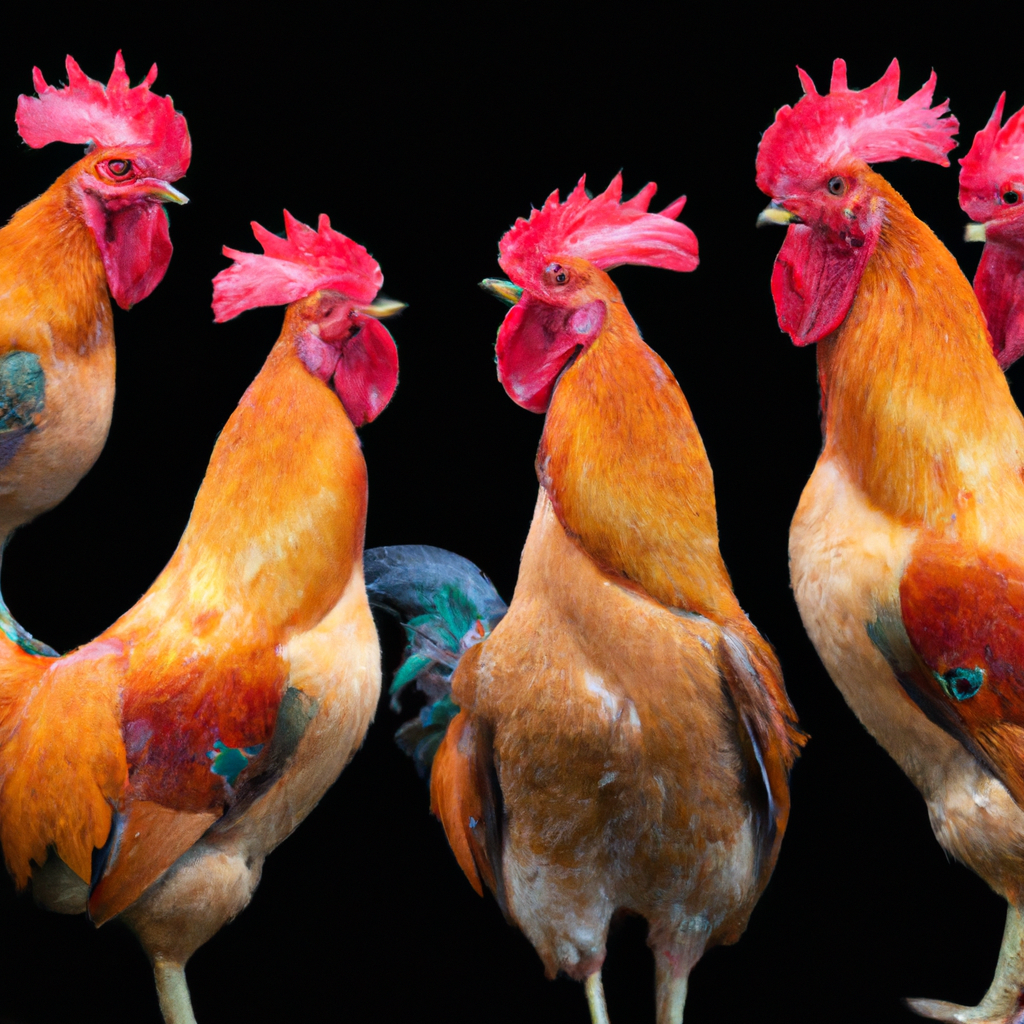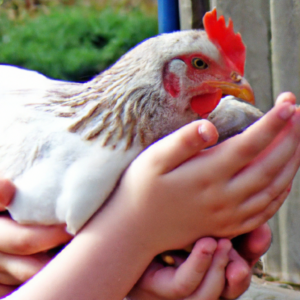
Are you ready to add a rooster to your flock of chickens? Wondering how to ensure a smooth integration and minimize any potential conflicts? Look no further! In this article, we’ll explore the best techniques for introducing a rooster into an existing flock, providing you with the knowledge and tips you need to create a happy and harmonious feathered community. So, grab a cup of coffee, relax, and let’s embark on this exciting adventure together!

Selecting the Right Rooster
Choosing the Right Breed
When selecting a rooster to add to your existing flock, it is important to consider the breed. Different breeds have different characteristics and temperaments, so choosing a rooster that is compatible with your existing flock is essential. Some breeds are known to be more docile and gentle, while others may be more aggressive or dominant. Researching the different breeds and their traits can help you make an informed decision.
Looking for a Healthy Rooster
Before bringing a rooster into your flock, it is crucial to ensure that he is healthy. Look for roosters that have bright eyes, clean feathers, and a lively appearance. Check for any signs of illness, such as labored breathing or discolored comb and wattles. It is also a good idea to ask the seller or breeder about the rooster’s health history and any vaccinations or treatments he has received.
Considering Temperament
The temperament of a rooster is another important factor to consider when adding him to your flock. A rooster with a calm and friendly temperament is more likely to integrate well with the other chickens and create a harmonious dynamic. Avoid choosing a rooster that exhibits signs of excessive aggression or dominance, as this can lead to conflicts within the flock. Observing the rooster’s behavior before bringing him home can give you an idea of his temperament.
Determining the Appropriate Age
The age of the rooster also plays a role in how well he will integrate into your existing flock. Younger roosters, typically around 4 to 6 months old, tend to have an easier time integrating as they are more adaptable and less set in their ways. Older roosters, on the other hand, may have already established their dominance and may face more challenges when joining a new flock. Considering the age of the rooster and how it may affect the dynamics within your flock is important for a successful integration process.
Understanding Flock Dynamics
Observing the Existing Flock
Before introducing a new rooster to your flock, take the time to observe the dynamics within your existing flock. Pay attention to the behavior of the hens, their social hierarchy, and any existing conflicts or pecking order disputes. This will help you understand the current dynamics and anticipate any potential challenges or issues that may arise when adding a new rooster to the mix.
Understanding the Pecking Order
Chickens have a social structure known as the pecking order, where each hen and rooster has a rank and hierarchy within the flock. This order determines who has access to resources and establishes the overall social dynamics. When introducing a new rooster, it is important to understand how the existing pecking order may be affected. The new rooster may try to assert his dominance, which can lead to conflicts and challenges within the flock.
Establishing Rooster Hierarchy
When integrating a new rooster, it is essential to establish a clear hierarchy among the roosters. This can be done through supervised interactions and natural dominance displays. Allow the roosters to establish their ranks and resolve any conflicts that may arise. It is important to closely monitor these interactions to ensure that they do not escalate into excessive aggression or harm.
Recognizing Compatibility Issues
Not all roosters will get along with each other. Some roosters may have dominant personalities and may not tolerate the presence of another rooster. It is crucial to recognize compatibility issues and assess whether the roosters can coexist without significant aggression or stress. If compatibility issues arise, it may be necessary to separate the roosters or find alternative solutions to ensure the safety and well-being of the flock.

Quarantine and Separation
Importance of Quarantine
Before introducing a new rooster to your flock, it is highly recommended to quarantine him for a period of time. Quarantine allows you to monitor the new rooster for any signs of illness or disease without exposing your existing flock. This helps prevent the spread of potential infections and ensures the overall health of your flock.
Separating the Rooster Initially
When bringing a new rooster home, it is important to keep him separate from your existing flock initially. This allows the rooster to acclimate to his new surroundings and reduces the chances of aggressive interactions between the rooster and the hens. Provide the new rooster with a separate enclosure or utilize a separate section within your existing coop.
Allowing Visual Introduction
During the quarantine period, it is beneficial to allow the new rooster and the existing flock to observe each other visually. This can be done by keeping them in separate enclosures within visual range of each other. Visual introduction allows the chickens to become familiar with each other’s presence, reducing the chances of aggression when they are eventually integrated.
Gradual Integration
Once the quarantine period is complete and the new rooster has been given a clean bill of health, it is time to begin the integration process. Gradual integration is recommended to minimize stress and aggression. Start by allowing short supervised interactions between the new rooster and a few hens at a time, gradually increasing the duration and number of interactions over a period of several weeks. This gradual approach allows the chickens to establish new relationships and adjust to the new dynamics within the flock.
Introducing the Rooster
Using the ‘Look But Don’t Touch’ Method
When first introducing the rooster to the flock, it is best to use the ‘Look But Don’t Touch’ method. This involves allowing the chickens to see and interact with each other through a barrier, such as a wire fence or mesh. This initial introduction allows the chickens to become familiar with each other’s presence and behavior without direct physical contact.
Providing Time Outside the Coop
As the integration process progresses, provide the rooster and the flock with supervised time outside the coop. This allows for more natural interactions and socialization among the chickens. Monitor their behavior closely to ensure that there are no signs of aggression or excessive dominance.
Supervised Face-to-Face Encounters
Once the chickens have become accustomed to each other’s presence and have shown positive interactions through the barrier, supervised face-to-face encounters can be initiated. This should be done in a controlled environment where you can intervene if necessary. Be prepared to separate any chickens that exhibit excessive aggression or engage in dangerous behavior.
Monitoring Interactions
Throughout the integration process, it is crucial to continuously monitor the interactions between the new rooster and the existing flock. Look for signs of aggression, excessive dominance, or stress in any of the chickens. Pay attention to body language, vocalizations, and any physical altercations. If any issues arise, step in to separate the chickens and assess the situation to prevent further conflicts.

Providing Adequate Space
Understanding Space Requirements
To successfully integrate a rooster into your flock, it is important to provide adequate space for all the chickens. Each chicken should have enough room to move, stretch their wings, and engage in natural behaviors. Consider the breed and size of your chickens when determining the appropriate space requirements.
Avoiding Overcrowding
Overcrowding can lead to increased aggression and stress among the chickens. Ensure that your coop and outdoor area provide enough space for the entire flock to coexist comfortably. If overcrowding becomes an issue, consider expanding the coop or reducing the number of chickens in your flock.
Ensuring Multiple Food and Water Stations
Providing multiple food and water stations is essential to prevent resource competition and aggression. Each chicken should have easy access to food and water without having to compete or fight for it. Place the stations in different areas of the coop or outdoor space to distribute the flock and minimize conflicts during feeding and drinking times.
Providing Sufficient Roosting Options
Roosting space is important for chickens to rest and sleep comfortably. Ensure that your coop has enough roosting options for all the chickens, including the new rooster. Provide roosts at different heights and in various locations to give the chickens options and minimize potential conflicts over preferred roosting spots.
Ensuring Sufficient Resources
Avoiding Resource Competition
Resource competition can lead to aggression and stress within the flock. To prevent this, ensure that there are enough resources available for all the chickens. This includes food, water, nesting boxes, and dust bath areas. Monitor the resources regularly and replenish them as needed to maintain harmony in the flock.
Providing Sufficient Feed and Water
It is crucial to provide sufficient feed and water for the entire flock, including the new rooster. Make sure the chickens have access to nutritious feed and clean water at all times. Consider the feeding habits and preferences of different chickens when determining the number and placement of feeders and waterers.
Offering Multiple Nesting Boxes
Each hen should have access to a nesting box to lay her eggs comfortably. Providing multiple nesting boxes can help prevent competition and aggression among the hens. Additionally, offering a suitable and secluded nesting environment encourages the hens to lay eggs without disturbance, promoting an overall peaceful atmosphere within the flock.
Ensuring Sufficient Dust Bath Area
Chickens engage in dust bathing as a natural behavior to maintain their feather and skin health. Providing a sufficient dust bath area is important for the well-being of the flock. Make sure the dust bath area is large enough for multiple chickens to use at the same time and has enough loose soil or sand for effective dust bathing.

Managing Aggression
Addressing Rooster Aggression
If the new rooster exhibits aggression towards the hens or other roosters, it is important to address the issue promptly. Separate the aggressive rooster temporarily and assess the underlying causes of his behavior. Consult with poultry experts or veterinarians for guidance on managing rooster aggression and implementing appropriate corrective measures.
Implementing Distraction Techniques
To manage aggression within the flock, distraction techniques can be useful. For example, providing multiple sources of food or scattering treats in different areas of the coop or outdoor space can divert the chickens’ attention away from potential conflicts. By offering alternative outlets for their energy and focus, you can help reduce aggression among the chickens.
Identifying Signs of Excessive Aggression
While some level of aggression is normal within a flock, it is essential to recognize signs of excessive aggression that may lead to serious injuries or distress. Pay attention to aggressive behaviors such as constant chasing, feather pulling, or repeated attacks. If these signs are observed, it may be necessary to intervene and separate the aggressive chickens to maintain the safety and well-being of the flock.
Separating Aggressive Individuals
If the aggression within the flock becomes unmanageable or poses a serious threat, it may be necessary to permanently separate the aggressive individuals. This can involve creating separate enclosures or rehoming the aggressive chickens. Prioritize the safety and welfare of the entire flock when making these decisions.
Supervising the Integration Process
Maintaining Close Observation
Throughout the integration process, it is crucial to maintain close observation of the flock. Regularly check on the chickens, especially during interaction periods, to ensure their safety and well-being. Pay attention to any signs of distress or stress and intervene if necessary to prevent potential conflicts or injuries.
Monitoring for Injuries and Stress
Integrating a new rooster can be a stressful process for both the new arrival and the existing flock members. Monitor the chickens for any signs of injuries or excessive stress. Inspect their feathers, comb, and wattles for any wounds or signs of aggression. Address any injuries promptly and provide necessary care to prevent further complications.
Identifying Signs of Successful Integration
As the integration process progresses, look for signs of successful integration among the flock. Positive indicators include calm interactions, reduced aggression, and a harmonious social dynamic. Observe the chickens’ behavior, body language, and vocalizations to gauge their overall well-being and contentment.
Stepping in if Necessary
If conflicts or excessive aggression persist despite your efforts, it may be necessary to step in and make additional interventions. This can involve separating certain chickens, adjusting the integration process, or seeking professional advice to address the specific challenges you are facing. Prioritize the safety and health of the flock and be prepared to adapt your approach accordingly.
Seeking Professional Advice
Consulting Veterinarians or Poultry Experts
If you encounter significant challenges during the integration process or have concerns about the well-being of your flock, consider consulting with veterinarians or poultry experts. These professionals can provide valuable guidance, assess the specific dynamics of your flock, and offer tailored solutions to address any issues you are facing.
Finding Supportive Communities and Forums
Joining supportive communities and forums dedicated to chicken keeping can be immensely helpful when integrating a rooster into your flock. Members of these communities often have firsthand experience and can share practical tips, advice, and personal anecdotes to assist you throughout the process. Building connections with knowledgeable chicken enthusiasts can provide invaluable support and guidance.
Attending Workshops or Events
Attending workshops, seminars, or local events focused on poultry care and management can expand your knowledge and skills in integrating roosters into a flock. These educational opportunities often provide expert insights, hands-on demonstrations, and networking opportunities with other poultry enthusiasts. Take advantage of these events to deepen your understanding and gain valuable perspectives.
Considering Professional Services
In some cases, particularly if you are encountering significant challenges or have limited experience with integrating roosters, it may be worth considering professional services. Poultry consultants or trainers can provide personalized guidance, conduct on-site assessments, and offer solutions tailored to your specific situation. While this option may involve additional cost, it can provide peace of mind and expert assistance to ensure a successful integration process.
Conclusion
Integrating a rooster into an existing flock requires careful planning, observation, and management. By selecting the right breed, considering the rooster’s health and temperament, and understanding the dynamics within your flock, you can set the stage for a successful integration. Implementing strategies such as using the ‘Look But Don’t Touch’ method, providing adequate space and resources, managing aggression, and closely supervising the process can help ensure a harmonious coexistence among your chickens. Remember, seeking professional advice and support can be beneficial if you encounter challenges or need expert guidance. With patience, attention, and the right approach, you can successfully integrate a rooster into your flock and create a balanced, thriving chicken community.







